Fueling Visibility: A Distributor’s Guide to High-Brightness, Sunlight-Readable LCDs for European Fuel Dispensers
Executive summary (TL;DR)
European forecourt operators increasingly demand reliable, secure, and highly visible digital displays built into fuel dispensers. For distributors, this is a growth opportunity: the European digital signage sector is expanding, and fuel-pump digitalization (payment, advertising, customer info) creates recurring hardware and service revenue. Success hinges on understanding safety/regulatory constraints at fuel sites (ATEX/IEC), specifying the correct optical and mechanical features (≥1,000–5,000 nits, optical bonding, IP/IK ratings, thermal design), and offering integration services (mounting, touchscreen, payment-terminal compatibility, tamper protection, and lifecycle support). This guide gives you practical technical specs, regulatory context, procurement checklists, integration advice, commercial positioning, and realistic selling points to win EU distributors and integrators.
Digitization of forecourts has two consistent drivers: (1) improving customer experience (clear pricing, promos, instructions, loyalty prompts) and (2) unlocking new revenue through targeted advertising and upsell. European retailers and petrol brands want displays that remain legible in full daylight, survive the outdoor environment, and comply with hazardous-area rules. As retailers refresh forecourt equipment, distributors who can supply rugged, certified high-brightness LCDs plus integration services are in a premium position. Market reports show the broader European digital-signage market is growing strongly, presenting tailwinds for fuel-pump displays as part of DOOH and retail digitization strategies.
Recent market analyses estimate the European digital-signage market at several billion USD and forecast steady CAGR into the next decade. While fuel-pump displays are a niche within DOOH/retail signage, they piggyback on the overall DOOH growth as fuel retailers modernize, migrate to contactless/self-service models, and add programmatic advertising. Distributors should therefore treat fuel-pump projects as both hardware sales and multi-year service contracts (installation, spare parts, content management).
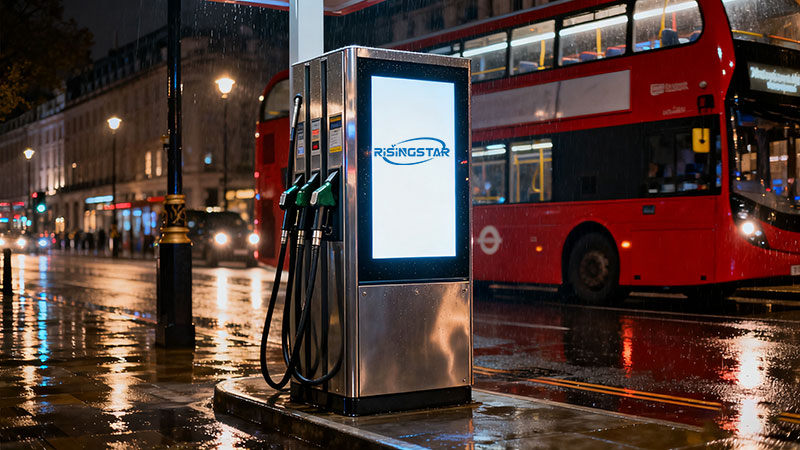
Fuel dispensers operate in an environment where flammable vapors can be present. In the EU, equipment used in potentially explosive atmospheres falls under ATEX (Directive 2014/34/EU) and the related IEC/EN standards (commonly the IEC 60079 series). Devices physically attached to or installed in proximity to dispenser nozzles, or that might be exposed to vapour ingress, must be assessed for suitability. The zone classification (e.g., Zone 0/1/2 for gases) determines the protection methods and required certification. Distributors must ensure either that (a) the display assembly is certified for the relevant zone or (b) the installation places the electronic device outside of classified areas and uses certified enclosures and cabling where needed. Always verify the vendor’s ATEX/IEC marking and documentation for the specific site use case.
Practical note: Many modern fuel dispenser displays are installed inside the dispenser cabinet or behind sealed windows; the dispenser OEM will typically handle hazardous-area compliance. If you supply a retrofit display, coordinate with the dispenser manufacturer and ask for a hazards-assessment / declaration of conformity.
Fuel sites also require controls for electrostatic hazards (IEC/TS 60079-32-1 guidance and related practices). Design and installation must avoid configurations susceptible to sparking or charge accumulation (e.g., conductive enclosures properly earthed). Distributors advising integrators should insist on proper bonding/earthing and documented risk controls.
Beyond ATEX/IEC, expect to verify CE/EMC compliance, RoHS, and for some markets UL/EN equivalents. Fuel sites are subject to local installation standards and dispenser manufacturer rules; the safest route is to partner with certified dispenser OEMs or use vendor displays with clear certification packages.
Below are the line items that determine whether a display will work reliably on a fuel pump. For each item I explain what to ask for and what typical values mean in practice.
Minimum sunlight-readable baseline: ~1,000 nits. In practice, for direct sunlight on European latitudes you’ll often require 1,500–3,000 nits; premium installations (south-facing, full afternoon sun) may require 3,000–5,000 nits. The “nits” number measures luminous intensity per area; higher is better for legibility but increases power and thermal demands.
Why it matters: Under direct sun, typical indoor screens (200–400 nits) wash out. A 1,000–5,000 nit display combined with AR/AG coatings and optical bonding retains contrast and readability.
High contrast (native LCD contrast plus optical bonding) helps legibility in glare. Optical bonding—laminating a protective coverglass directly to the LCD—reduces internal reflections, increases perceived contrast, and improves durability. Ask vendors about optical bonding and AR coatings.
AR coatings reduce specular reflection; anti-glare diffuses scattered light. Best practice: combine AR glass with optical bonding for maximum benefit.
Direct-type LED backlight (full array/mini-LED) vs. edge-lit. Direct LED with local dimming provides higher uniform brightness and better thermal distribution—important for 1,500+ nits designs. Confirm vendor backlight lifetime (typical MTBF/backlight life claims: ≥50,000 hours).
Fuel sites can experience large temp swings. Look for displays rated for −20°C to +70°C or similar, with active or passive thermal management. High brightness produces heat—vendor thermal specs and heat-dissipation design are critical.
IP65/66/67 for water/dust sealing is common. For dispensers exposed to splashes and jet-washing, prefer IP66/67. For vandal resistance, IK08–IK10 impact ratings are advisable.
Fuel-pump niches are compact. Offer slim profile displays and confirm rear mounting, bezel cutouts, cable routing, and gasket details. Retrofit jobs often require custom bezels or mounting brackets.
If you offer touchscreen (for promos, touch ordering), specify PCAP vs resistive. PCAP offers better durability and multi-touch but requires proper glove sensitivity or software configuration for gloved users. Ensure touch surfaces are hardened and bonded.
Higher brightness increases power draw. Distributors should present realistic energy profiles (W at 1,000 nits vs at 3,000 nits) to forecourt owners, balancing legibility and running costs.
Backlight life, overall MTBF, and ease of replacing modules (LCD module, power supply, controller) determine TCO. Look for 50,000 hours or higher and modular designs enabling field replacement.
Support for common signage players (Android boards, Windows small form factor, OPS, or integrated SoC) and secure remote content management is essential. Consider cellular backup (4G/5G) for remote sites. Also plan for secure software updates and endpoint hardening.
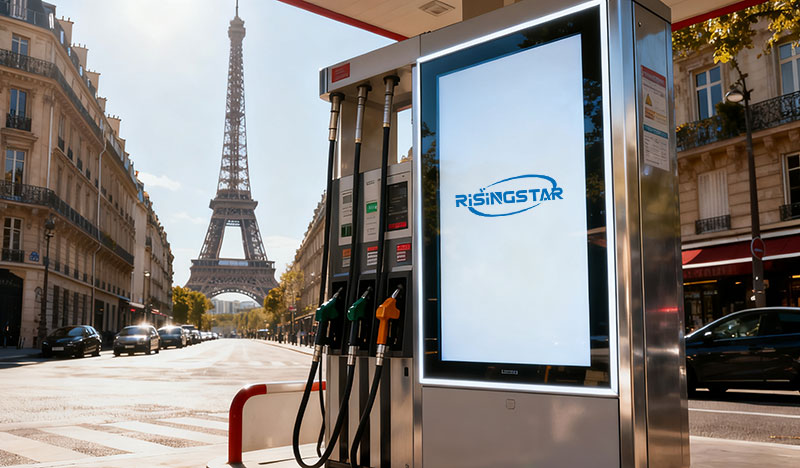
Never assume a generic display can be bolted into a pump. Coordinate with the dispenser manufacturer. For retrofits, obtain a documented hazards assessment and confirm whether the display assembly must be ATEX-certified or whether the dispenser structure maintains the defined separation. If the display is installed behind the dispenser window inside a sealed cabinet, the OEM installation procedure will typically define acceptable components and cabling.
Use IP66/67-rated enclosures with gasketing suitable for petrol vapours. Avoid design choices that create internal condensation pockets—consider hydrophobic vents or desiccant packs where relevant.
Provide a thermal path from the display electronics to the dispenser structure or heatsink. For very highbrightness panels, evaluate forced convection or thermally conductive mounts. Monitor internal temps during commissioning.
Use shielded cabling and follow EMC guidance for nearby payment terminals and RF equipment. Grounding and bonding must be carefully designed to avoid creating new ignition hazards.
If enabling touch, consider glove mode and wet-touch compensation. Also design UI elements with large targets to avoid accidental presses at the nozzle or during fueling.
Secure boot, signed firmware, encrypted content transport, and remote patching capabilities are table stakes for long deployments. Offer managed signage services or partner with CMS providers.
Use this as a template when you request quotes from manufacturers or present options to customers:
Panel size: 7" / 10.1" / 15.6" / 21.5" (common pump sizes vary—confirm cutout)
Brightness: 1,500 / 2,500 / 3,500 / 5,000 nits options
Contrast ratio: 1000:1 (typical) + optical bonding (specify AR coating)
Panel type: IPS / Commercial TFT with direct LED backlight
Backlight life: ≥ 50,000 hours (to 50% brightness)
Operating temp: −20°C to +70°C (model dependent)
Ingress protection: IP66 / IP67 (front)
Impact rating: IK08 or IK10 (optional)
ATEX / IECEx: available on request (device marking if applicable)
Touch: PCAP projected capacitive (glove & wet mode supported)
Connectivity: HDMI / LVDS / eDP input + optional Android signage player / 4G LTE modem
Power: 12V / 24V DC or AC options; power consumption at 1000 nits and at max brightness specified
Certifications: CE, RoHS, EMC (EN 55032/35), ATEX/IECEx documentation (if applicable)
Serviceability: replaceable controller board, spare parts availability, firmware OTA capability
Reference vendors commonly list similar specs and claim high-brightness ranges of 500–5,000 nits for outdoor signage and fuel dispenser uses.
OEM integration example (typical): A dispenser manufacturer specifies a display module to be installed behind a sealed window, with the module located inside the cabinet. The dispenser manufacturer maintains the hazardous-area conformity; the display vendor supplies an industrial-grade panel (2,500 nits), optical bonding, and a sealed connector harness. The result: consistent appearance, easy servicing by approved technicians, and compliance maintained through the dispenser’s conformity documentation.
Retrofit example (typical): A convenience chain wants to upgrade promo screens on existing pumps. A retrofit kit with an IP66 bezel and a 1,500 nits industrial display is used. The integrator must perform a local hazards assessment and work with the pump owner; frequently this route restricts the electronics from being directly exposed to the nozzle area and uses sealed windows or external housings.
These practical choices illustrate why distributors must be able to advise customers on both hardware and compliance paths. Vendor datasheets often note the intended application areas (EV charge points, fuel dispensers, outdoor kiosks) demonstrating that modern high-brightness panels are designed for these contexts.
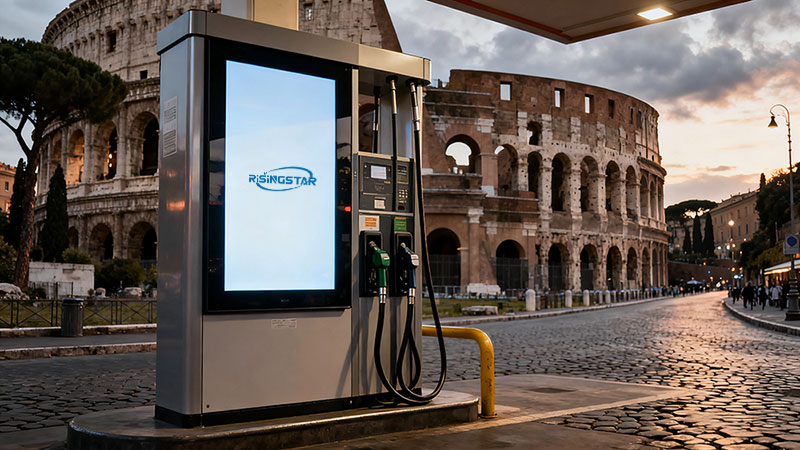
Differentiators to emphasize: certified safety/evidence for hazardous areas (if available), brightness options (tailor to latitude/exposure), long backlight life (50k hours), modular serviceability, low-power industrial designs (lower running cost), and proven harsh-environment ruggedness (IP/IK ratings).
Service offering: installation/commissioning kits, cutout templates, gasketed bezels, spare parts packs, and content/CMS partnerships.
Financing & recurring revenue: sell hardware plus managed signage/CMS subscriptions and spare-parts contracts.
High-brightness panels (especially >2,500 nits with optical bonding) are premium SKUs. TCO conversations should include not just acquisition cost but energy, maintenance, and replacement cadence. Provide comparative operating-cost scenarios for 1,000 vs 3,000 nits to justify premium options.
Discovery: site exposure (sun path), dispenser OEM/make, hazardous-area classification, existing power & network.
Recommendation: select brightness, IP/IK level, mounting approach (OEM cavity vs retrofit).
Compliance check: verify ATEX/IEC/dispense OEM requirements.
Pilot: propose 1–3 site pilot with monitoring & ROI measurement (ad impressions, uptime).
Rollout & service: scale with spare kit provisioning and managed CMS.
When evaluating vendors or preparing a bid, use this checklist:
Vendor-provided technical datasheet (full electrical, mechanical, optical specs).
Brightness curve vs power consumption (W at multiple nits levels).
Backlight lifetime and end-of-life brightness spec.
Operating temperature and derating strategy at high temps.
IP/IK ratings and test reports.
Optical bonding and AR/AG coating details (vendor test data on reflectance).
ATEX/IECEx or documented compatibility guidance for hazardous areas. If vendor lacks ATEX, ask for guidance on safe mounting outside classified zones.
EMC/EMI test reports (EN 55032/35 or equivalent).
Mechanical drawings, cutout templates, gasketing and mounting details.
Serviceability and spare parts availability in EU/region.
Warranty terms (backlight and panel warranty specifics).
Proof of prior forecourt deployments or references.
Software stack and CMS integration options; secure update mechanism.
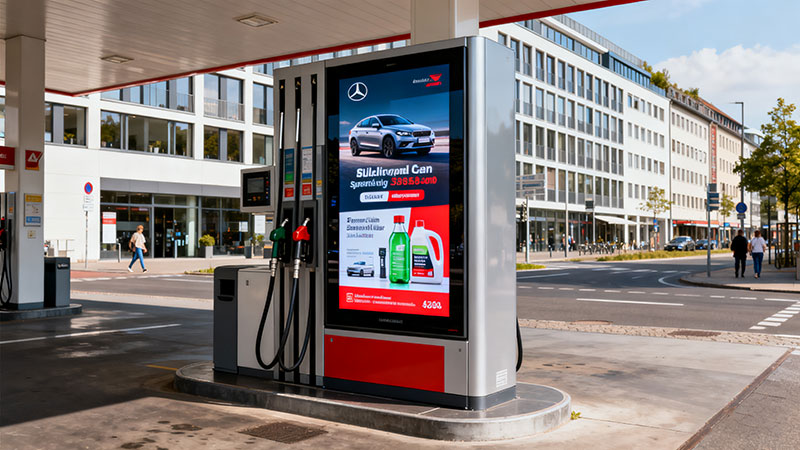
Q: How many nits do I really need for a fuel pump in Spain vs Northern Europe?
A: Spain or southern exposures with strong afternoon sun benefit from 2,500–5,000 nits. Northern Europe or shaded pumps may work well with 1,000–2,000 nits. Always combine brightness selection with optical bonding and AR coatings for best legibility.
Q: Do I need ATEX certified displays?
A: Not always. If the display will be installed within a classified zone or could be directly exposed to petrol vapours, ATEX/IECEx certification is required. If the display is mounted outside the classified area (for example behind a sealed window or inside the dispenser cabinet with OEM conformity), the dispenser OEM’s documentation often governs compliance. Confirm with the dispenser manufacturer and local certifying body.
Q: What about vandalism and washdown exposure?
A: Specify IK08–IK10 for impact resistance and IP66/67 for washdown. Use toughened cover glass and recessed mounting to reduce tamper risk.
Q: How long will the screen remain bright?
A: Backlights are typically rated for tens of thousands of hours (many vendors claim ~50,000 hours); brightness will diminish over time—vendors should provide a lumen/brightness vs operating hours curve.
Q: Is optical bonding necessary?
A: Highly recommended. Optical bonding reduces reflection, increases contrast, and helps resist moisture ingress between glass and panel. It significantly improves perceived readability in bright conditions.
Pitfall: Selecting a very high-brightness panel but ignoring thermal dissipation → Mitigation: Require vendor thermal test data; specify thermal conduction mounting.
Pitfall: Installing un-certified electronics into a classified zone → Mitigation: Early engagement with dispenser OEM and local certifying authority; prefer OEM-approved retrofit kits.
Pitfall: Neglecting software security on public-facing screens → Mitigation: Enforce secure boot, signed updates, and encrypted communication; include endpoint monitoring.
Pitfall: Wrong touch tech for gloves/wet conditions → Mitigation: Test PCAP glove/wet modes and specify glove sensitivity or alternative input.
Basic Retrofit Kit (cost-sensitive): 1,500 nits, IP66 bezel, 7–10" display, sealed cabling kit, local installation instructions. Best for shaded pumps or secondary sites.
Standard Forecourt Kit (most common): 2,500 nits, optical bonding, AR glass, IP66/IK08, integrated Android signage player, 24/7 remote CMS access (monthly). Good balance of cost and daylight legibility.
Premium Full OEM (high exposure): 3,500–5,000 nits, optical bonding, IK10, IP67, ATEX-compatible options or OEM integration, cellular backup, managed content & service SLA. For flagship stations and advertising networks.
Stock common spare parts locally: controller boards, power supplies, cover glass, mounting gaskets.
Offer preventative maintenance: thermal checks, firmware health checks, brightness logging.
Provide a replacement policy for panels approaching end of life (e.g., when backlight drops below specified lumen levels).
Consider extended warranties and on-site swap services for large rollouts.
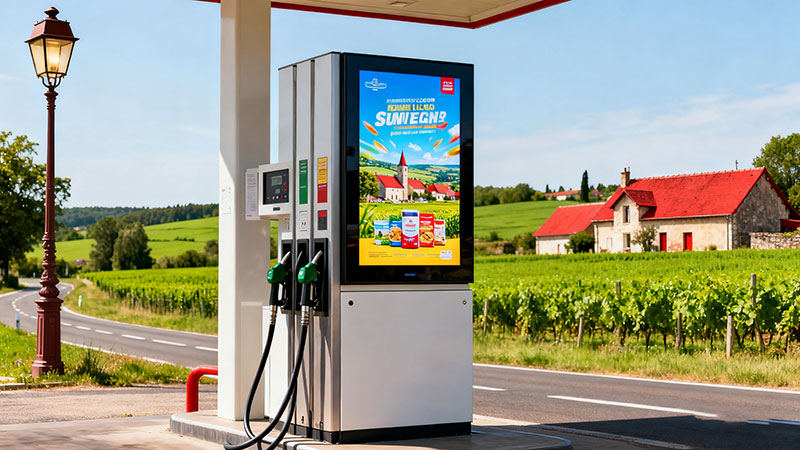
Green flags (good):
Vendor provides complete test reports (thermal, IP, IK, EMC).
Clear guidance or certification for hazardous areas (ATEX/IECEx or written OEM integration guidance).
Demonstrated forecourt references and EU local support.
Modular design with documented spare part availability.
Red flags (avoid):
Vague brightness claims without power/thermal data.
No documentation on ingress protection (no IP/IK test reports).
No guidance on hazardous-area installation or disclaimers that vendor “doesn’t support” fuel site installs.
Lack of local repair options or impossibly long lead times for spares.
ATEX Directive 2014/34/EU — equipment for potentially explosive atmospheres; critical for installations where vapour exposure is possible.
IEC 60079 series / EN 60079 — international standards covering equipment protection methods and requirements for explosive atmospheres.
IEC/TS 60079-32-1 — guidance on electrostatic hazards.
EN 13012 / dispenser mechanical standards — dispenser components & nozzles, relevant for dispenser OEM conformity.
EMC / Safety standards (EN 55032, EN 55035, CE marking) — for electromagnetic compatibility and CE compliance. (Request explicit test reports from vendors.)
Scenario: mid-sized convenience chain installs 100 mid-brightness (2,500 nits) displays at 100 stations. Revenue streams include improved in-store promotions, forecourt advertising, and increased loyalty conversions.
Hardware cost: X per display (vendor dependent).
Installation & integration: Y per site.
Ad revenue / upsell: Even modest CPM gains across peak hours quickly offset hardware costs—especially if displays are networked into programmatic DOOH networks. Use pilot data to quantify local uplift; present a 12–24 month payback scenario.
(Provide site-specific ROI modelling during sales process—include energy costs at the chosen brightness and warranty/service packages.)
Audit capabilities: Ensure your technical team can handle hazard assessments and coordinate with dispenser OEMs.
Build a vendor short-list: Prioritize vendors with documented IP/IK tests, thermal data, and ATEX/IEC guidance. (Request test reports.)
Offer bundled services: Sell displays plus installation, commissioning, and a managed CMS subscription.
Run pilots: Start with a 1–3 station pilot covering different sun exposures to gather real performance data.
Prepare spares & SLAs: Stock critical spares in EU and offer service SLAs for uptime.
Train installers: Ensure installation crews follow grounding, sealing, and EMC best practices.
Market to two buyer groups: (a) Dispenser OEMs and integrators (longer sales cycle but higher volume), (b) Retail chains / petrol brands (faster pilots, potential marketing ad revenue).
Fuel dispensers are more than pumps; they are a customer touchpoint and a DOOH medium. European forecourts are actively modernizing, and distributors who can pair high-brightness, rugged hardware with compliance knowledge and integration services win the best projects. The market growth for digital signage across Europe supports investment—choose the right technical partners, respect hazardous-area rules, pilot thoughtfully, and offer bundled services to convert hardware sales into recurring revenue streams.





Ask a quote for the latest price and one of our team members will respond as soon as possible.
